sensor TOYOTA BZ4X 2022 (in English) Owner's Guide
[x] Cancel search | Manufacturer: TOYOTA, Model Year: 2022, Model line: BZ4X, Model: TOYOTA BZ4X 2022Pages: 674, PDF Size: 120.02 MB
Page 269 of 674
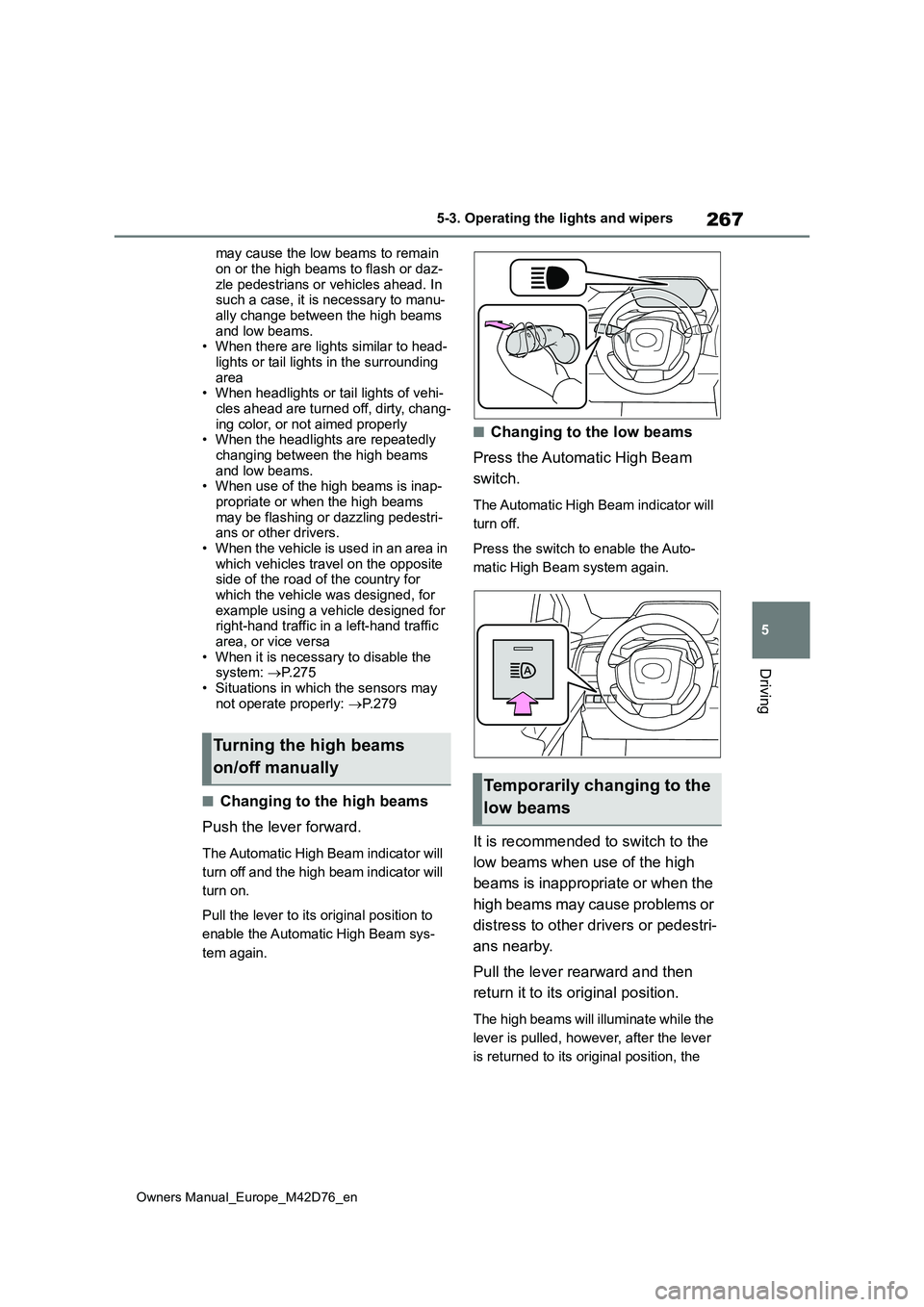
267
5
Owners Manual_Europe_M42D76_en
5-3. Operating the lights and wipers
Driving
may cause the low beams to remain
on or the high beams to flash or daz- zle pedestrians or vehicles ahead. In such a case, it is necessary to manu-
ally change between the high beams and low beams.• When there are lights similar to head-
lights or tail lights in the surrounding area• When headlights or tail lights of vehi-
cles ahead are turned off, dirty, chang- ing color, or not aimed properly• When the headlights are repeatedly
changing between the high beams and low beams.• When use of the high beams is inap-
propriate or when the high beams may be flashing or dazzling pedestri-ans or other drivers.
• When the vehicle is used in an area in which vehicles travel on the opposite side of the road of the country for
which the vehicle was designed, for example using a vehicle designed for right-hand traffic in a left-hand traffic
area, or vice versa • When it is necessary to disable the system: P. 2 7 5
• Situations in which the sensors may not operate properly: P. 2 7 9
■Changing to the high beams
Push the lever forward.
The Automatic High Beam indicator will
turn off and the high beam indicator will
turn on.
Pull the lever to its original position to
enable the Automatic High Beam sys-
tem again.
■Changing to the low beams
Press the Automatic High Beam
switch.
The Automatic High Beam indicator will
turn off.
Press the switch to enable the Auto-
matic High Beam system again.
It is recommended to switch to the
low beams when use of the high
beams is inappropriate or when the
high beams may cause problems or
distress to other drivers or pedestri-
ans nearby.
Pull the lever rearward and then
return it to its original position.
The high beams will illuminate while the
lever is pulled, however, after the lever
is returned to its original position, the
Turning the high beams
on/off manually
Temporarily changing to the
low beams
Page 272 of 674
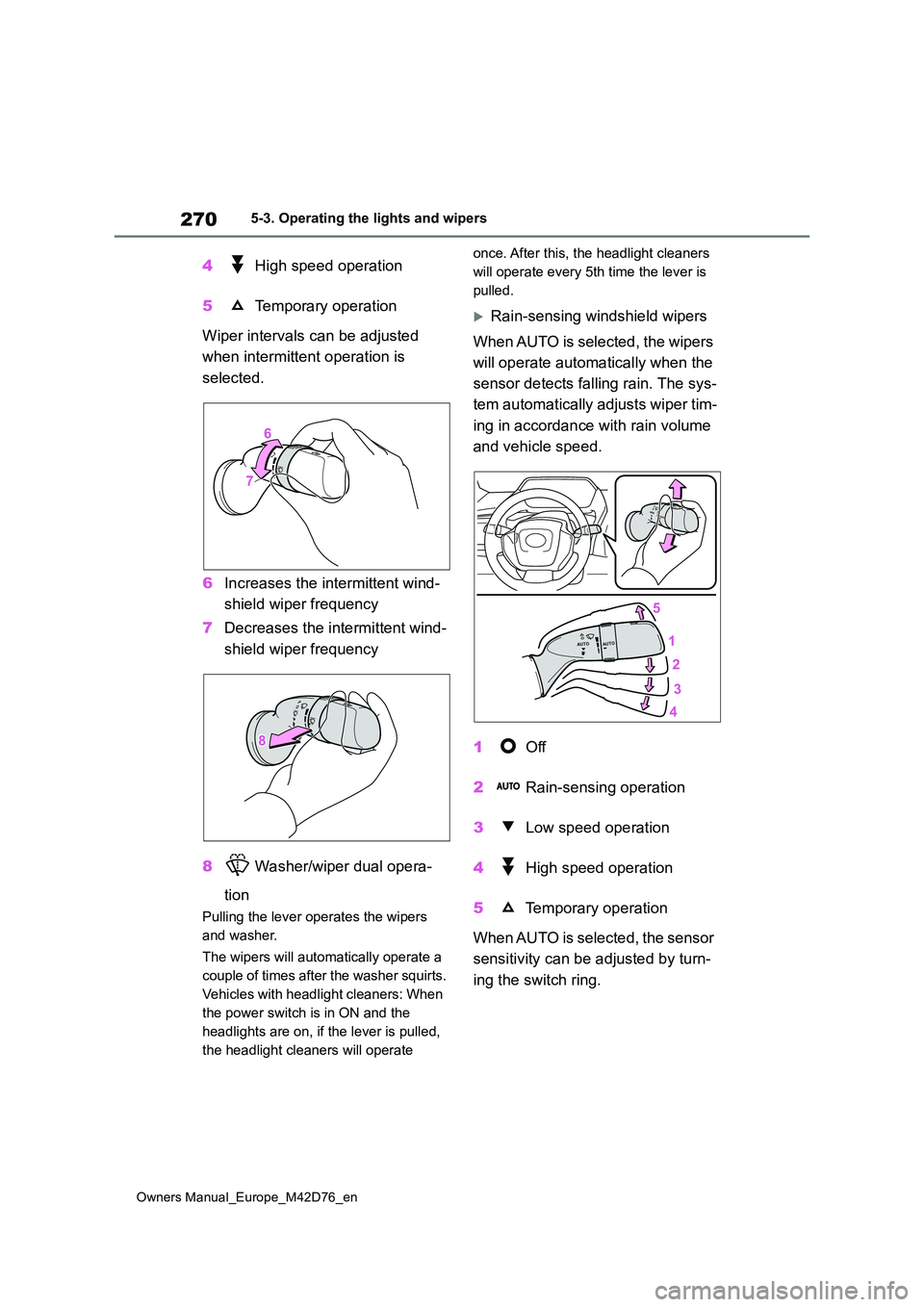
270
Owners Manual_Europe_M42D76_en
5-3. Operating the lights and wipers
4 High speed operation
5 Temporary operation
Wiper intervals can be adjusted
when intermittent operation is
selected.
6 Increases the intermittent wind-
shield wiper frequency
7 Decreases the intermittent wind-
shield wiper frequency
8 Washer/wiper dual opera-
tion
Pulling the lever operates the wipers
and washer.
The wipers will automatically operate a
couple of times after the washer squirts.
Vehicles with headlight cleaners: When
the power switch is in ON and the
headlights are on, if the lever is pulled,
the headlight cleaners will operate
once. After this, the headlight cleaners
will operate every 5th time the lever is
pulled.
Rain-sensing windshield wipers
When AUTO is selected, the wipers
will operate automatically when the
sensor detects falling rain. The sys-
tem automatically adjusts wiper tim-
ing in accordance with rain volume
and vehicle speed.
1 Off
2 Rain-sensing operation
3 Low speed operation
4 High speed operation
5 Temporary operation
When AUTO is selected, the sensor
sensitivity can be adjusted by turn-
ing the switch ring.
Page 273 of 674
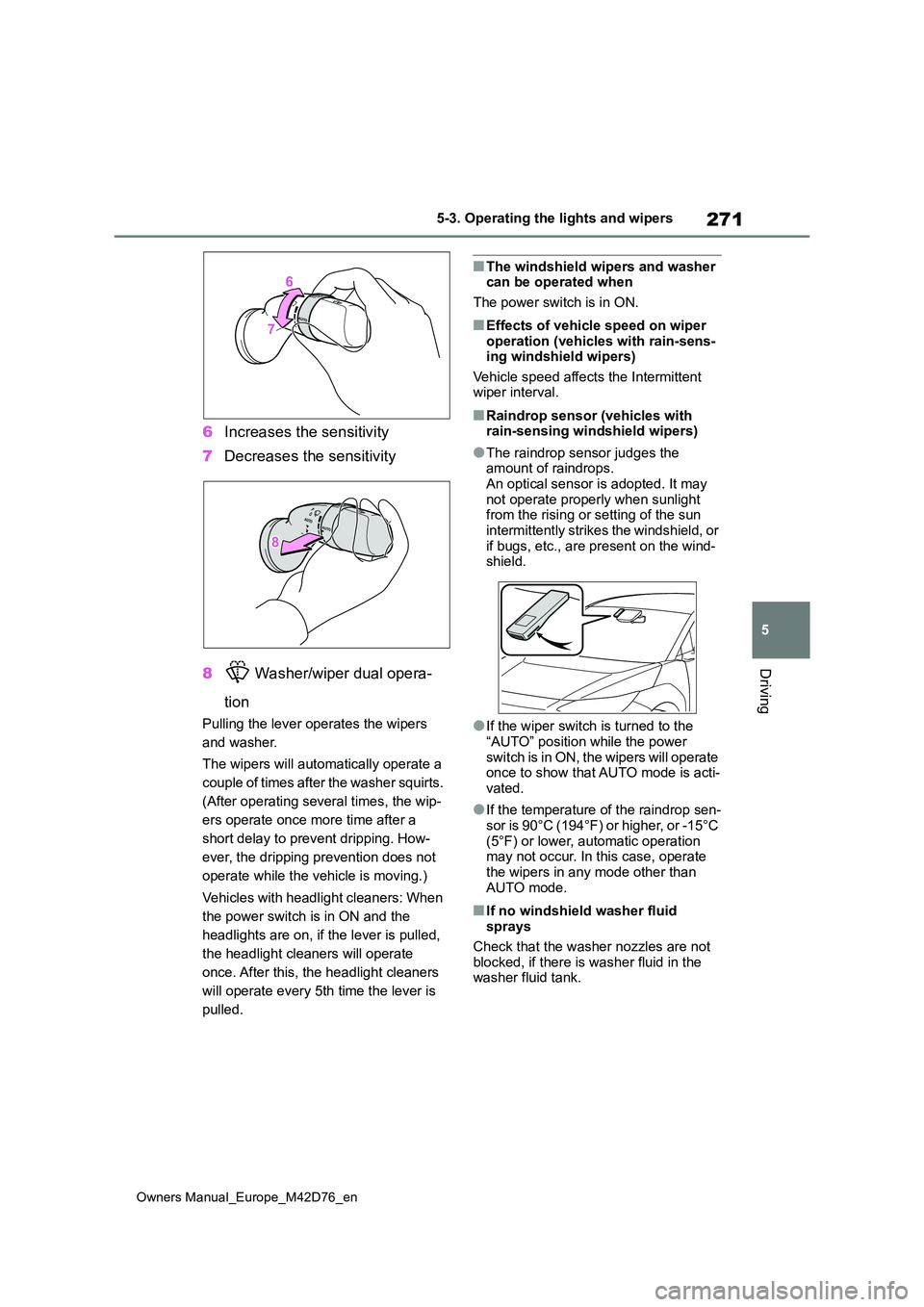
271
5
Owners Manual_Europe_M42D76_en
5-3. Operating the lights and wipers
Driving
6Increases the sensitivity
7 Decreases the sensitivity
8 Washer/wiper dual opera-
tion
Pulling the lever operates the wipers
and washer.
The wipers will automatically operate a
couple of times after the washer squirts.
(After operating several times, the wip-
ers operate once more time after a
short delay to prevent dripping. How-
ever, the dripping prevention does not
operate while the vehicle is moving.)
Vehicles with headlight cleaners: When
the power switch is in ON and the
headlights are on, if the lever is pulled,
the headlight cleaners will operate
once. After this, the headlight cleaners
will operate every 5th time the lever is
pulled.
■The windshield wipers and washer can be operated when
The power switch is in ON.
■Effects of vehicle speed on wiper operation (vehicles with rain-sens-ing windshield wipers)
Vehicle speed affects the Intermittent wiper interval.
■Raindrop sensor (vehicles with rain-sensing windshield wipers)
●The raindrop sensor judges the amount of raindrops.
An optical sensor is adopted. It may not operate properly when sunlight from the rising or setting of the sun
intermittently strikes the windshield, or if bugs, etc., are present on the wind-shield.
●If the wiper switch is turned to the “AUTO” position while the power
switch is in ON, the wipers will operate once to show that AUTO mode is acti-vated.
●If the temperature of the raindrop sen-
sor is 90°C (194°F) or higher, or -15°C (5°F) or lower, automatic operation may not occur. In this case, operate
the wipers in any mode other than AUTO mode.
■If no windshield washer fluid sprays
Check that the washer nozzles are not blocked, if there is washer fluid in the washer fluid tank.
Page 274 of 674
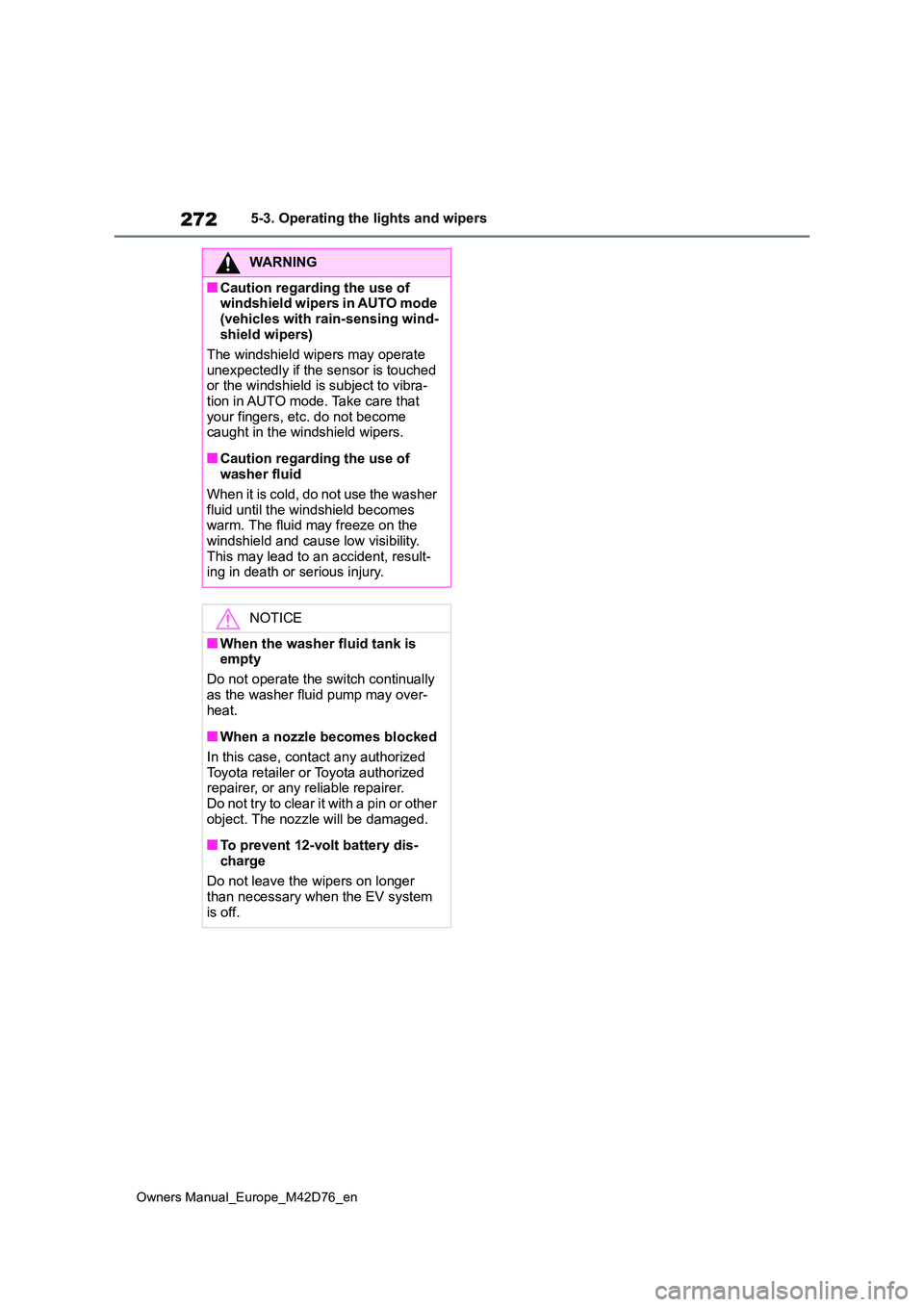
272
Owners Manual_Europe_M42D76_en
5-3. Operating the lights and wipers
WARNING
■Caution regarding the use of windshield wipers in AUTO mode
(vehicles with rain-sensing wind- shield wipers)
The windshield wipers may operate
unexpectedly if the sensor is touched or the windshield is subject to vibra-tion in AUTO mode. Take care that
your fingers, etc. do not become caught in the windshield wipers.
■Caution regarding the use of washer fluid
When it is cold, do not use the washer
fluid until the windshield becomes warm. The fluid may freeze on the windshield and cause low visibility.
This may lead to an accident, result- ing in death or serious injury.
NOTICE
■When the washer fluid tank is empty
Do not operate the switch continually
as the washer fluid pump may over- heat.
■When a nozzle becomes blocked
In this case, contact any authorized
Toyota retailer or Toyota authorized repairer, or any reliable repairer.Do not try to clear it with a pin or other
object. The nozzle will be damaged.
■To prevent 12-volt battery dis-
charge
Do not leave the wipers on longer than necessary when the EV system
is off.
Page 277 of 674

275
5
Owners Manual_Europe_M42D76_en
5-4. Using the driving support systems
Driving
Toyota Safety Sense
The Toyota Safety Sense con-
sists of the driving assist sys-
tems and contributes to a safe
and comfortable driving expe-
rience:
WARNING
■Toyota Safety Sense
The Toyota Safety Sense operates under the assumption that the driver will drive safely, and is designed to
help reduce the impact to the occu- pants in a collision and assist the driver under normal driving condi-
tions. As there is a limit to the degree of recognition accuracy and control performance that this system can pro-
vide, do not overly rely on this sys- tem. The driver is solely responsible for paying attention to the vehicle’s
surroundings and driving safely.
■For safe use
●Do not overly rely on this system. The driver is solely responsible for paying attention to the vehicle’s sur-
roundings and driving safely. This system may not operate in all situa-tions and provided assistance is
limited. Over-reliance on this sys- tem to drive the vehicle safely may lead to an accident resulting in
death or serious injury.
●Do not attempt to test the operation
of the system, as it may not operate properly, possibly leading to an accident.
●If attention is necessary while per-forming driving operations or a sys-
tem malfunction occurs, a warning message or warning buzzer will be operated. If a warning message is
displayed on the display, follow the instructions displayed.
●Depending on external noise, the volume of the audio system, etc., it may be difficult to hear the warning
buzzer. Also, depending on the road conditions, it may be difficult to recognize the operation of the sys-
tem.
■When it is necessary to disable
the system
In the following situations, make sure to disable the system.
Failure to do so may lead to the sys- tem not operating properly, possibly leading to an accident resulting in
death or serious injury.
●When the vehicle is tilted due to
being overloaded or having a flat tire
●When driving at extremely high speeds
●When towing another vehicle
●When the vehicle is being trans-
ported by a truck, ship, train, etc.
●When the vehicle is raised on a lift
and the tires are allowed to rotate freely
●When inspecting the vehicle using a drum tester such as a chassis dynamometer or speedometer tes-
ter, or when using an on vehicle wheel balancer
●When the vehicle is driven in a sporty manner or off-road
●When using an automatic car wash
●When a sensor is misaligned or
deformed due to a strong impact being applied to the sensor or the area around the sensor
●When accessories which obstruct a sensor or light are temporarily
installed to the vehicle
Page 278 of 674
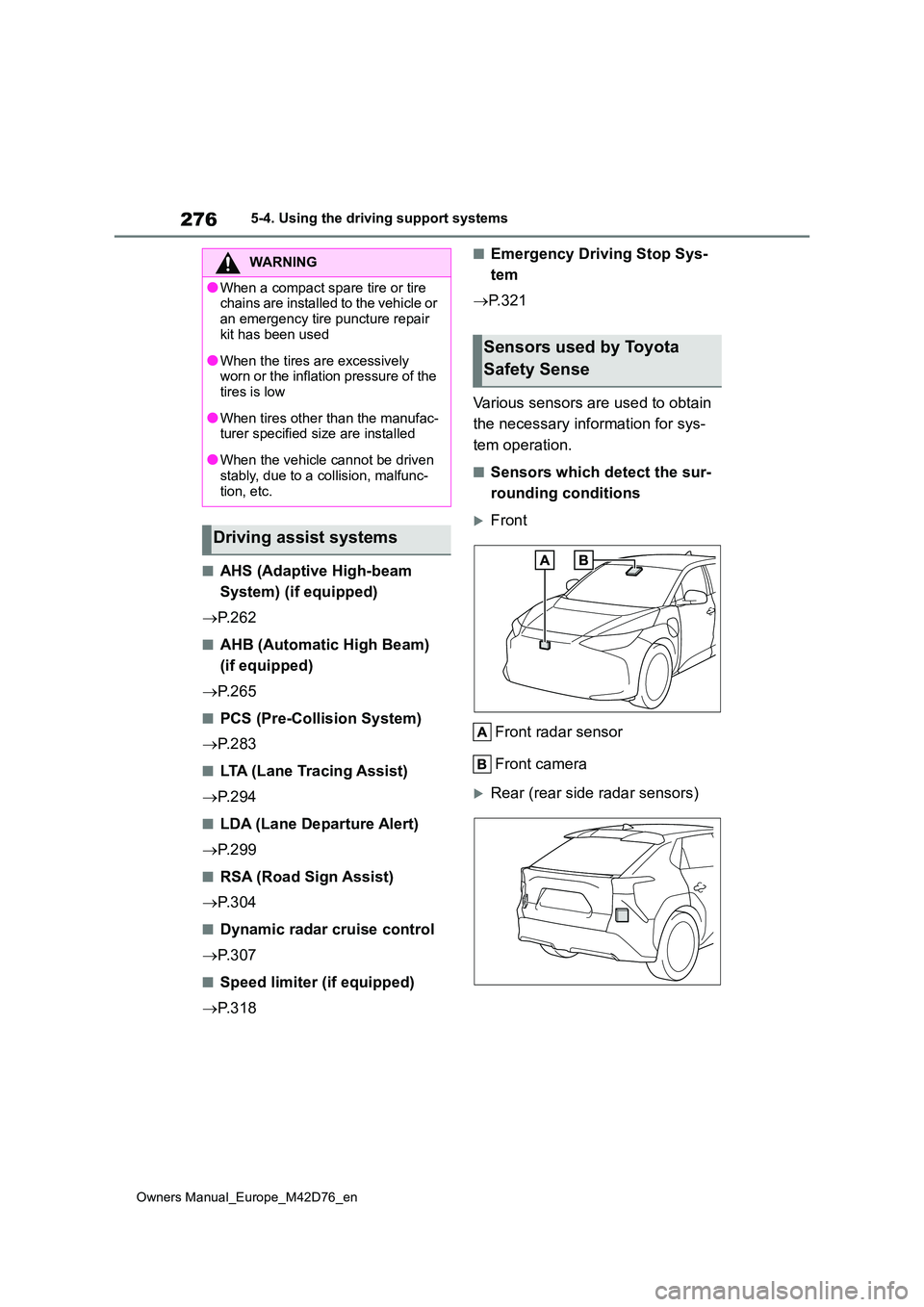
276
Owners Manual_Europe_M42D76_en
5-4. Using the driving support systems
■AHS (Adaptive High-beam
System) (if equipped)
P. 2 6 2
■AHB (Automatic High Beam)
(if equipped)
P. 2 6 5
■PCS (Pre-Collision System)
P. 2 8 3
■LTA (Lane Tracing Assist)
P. 2 9 4
■LDA (Lane Departure Alert)
P. 2 9 9
■RSA (Road Sign Assist)
P. 3 0 4
■Dynamic radar cruise control
P. 3 0 7
■Speed limiter (if equipped)
P. 3 1 8
■Emergency Driving Stop Sys-
tem
P. 3 2 1
Various sensors are used to obtain
the necessary information for sys-
tem operation.
■Sensors which detect the sur-
rounding conditions
Front
Front radar sensor
Front camera
Rear (rear side radar sensors)
WARNING
●When a compact spare tire or tire chains are installed to the vehicle or
an emergency tire puncture repair kit has been used
●When the tires are excessively worn or the inflation pressure of the tires is low
●When tires other than the manufac-turer specified size are installed
●When the vehicle cannot be driven stably, due to a collision, malfunc-
tion, etc.
Driving assist systems
Sensors used by Toyota
Safety Sense
Page 279 of 674
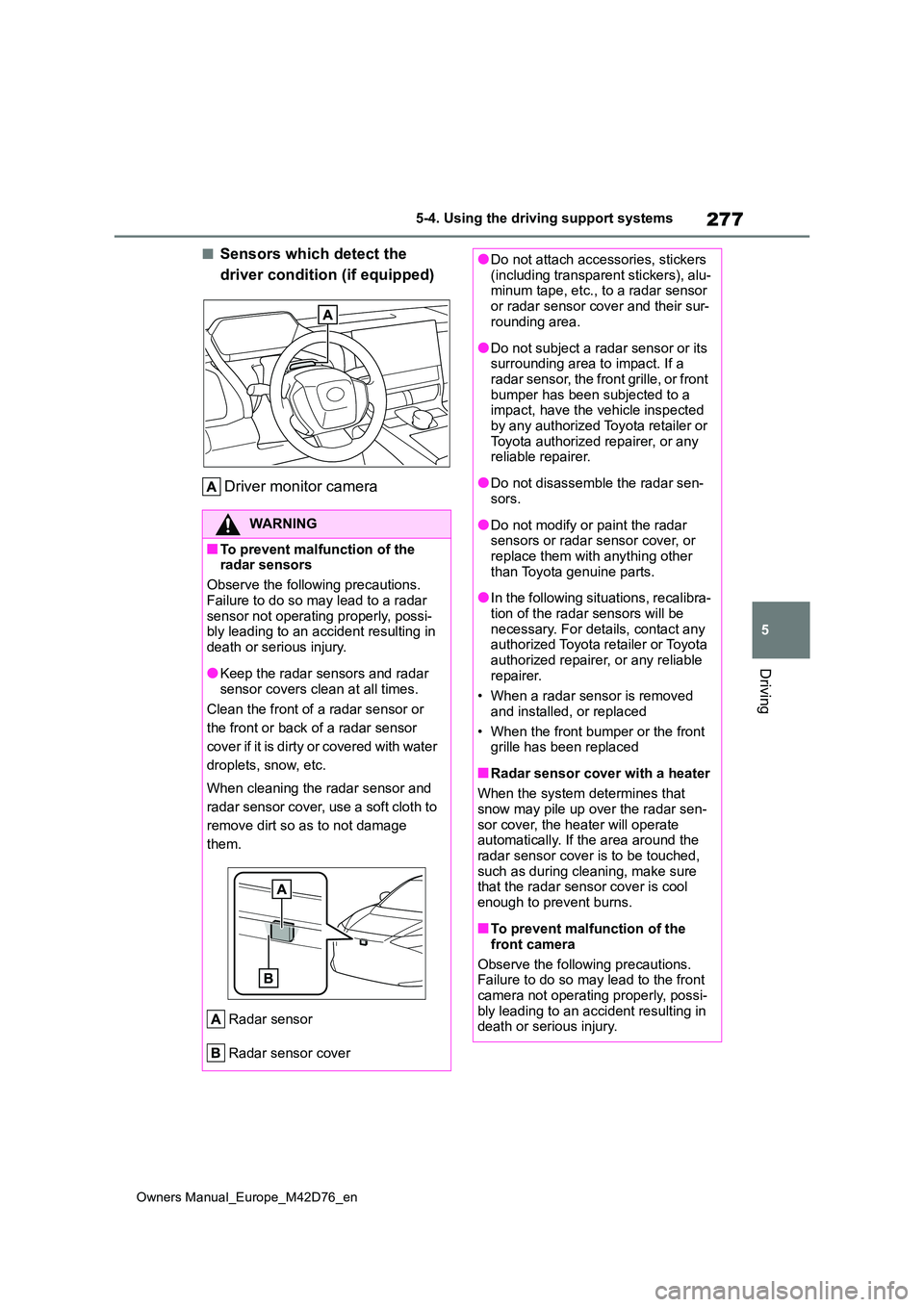
277
5
Owners Manual_Europe_M42D76_en
5-4. Using the driving support systems
Driving
■Sensors which detect the
driver condition (if equipped)
Driver monitor camera
WARNING
■To prevent malfunction of the radar sensors
Observe the following precautions.
Failure to do so may lead to a radar sensor not operating properly, possi-bly leading to an accident resulting in
death or serious injury.
●Keep the radar sensors and radar
sensor covers clean at all times.
Clean the front of a radar sensor or
the front or back of a radar sensor
cover if it is dirty or covered with water
droplets, snow, etc.
When cleaning the radar sensor and
radar sensor cover, use a soft cloth to
remove dirt so as to not damage
them.
Radar sensor
Radar sensor cover
●Do not attach accessories, stickers (including transparent stickers), alu-minum tape, etc., to a radar sensor
or radar sensor cover and their sur- rounding area.
●Do not subject a radar sensor or its surrounding area to impact. If a radar sensor, the front grille, or front
bumper has been subjected to a impact, have the vehicle inspected by any authorized Toyota retailer or
Toyota authorized repairer, or any reliable repairer.
●Do not disassemble the radar sen-sors.
●Do not modify or paint the radar sensors or radar sensor cover, or replace them with anything other
than Toyota genuine parts.
●In the following situations, recalibra-
tion of the radar sensors will be necessary. For details, contact any authorized Toyota retailer or Toyota
authorized repairer, or any reliable repairer.
• When a radar sensor is removed
and installed, or replaced
• When the front bumper or the front grille has been replaced
■Radar sensor cover with a heater
When the system determines that
snow may pile up over the radar sen- sor cover, the heater will operate automatically. If the area around the
radar sensor cover is to be touched, such as during cleaning, make sure that the radar sensor cover is cool
enough to prevent burns.
■To prevent malfunction of the
front camera
Observe the following precautions. Failure to do so may lead to the front
camera not operating properly, possi- bly leading to an accident resulting in death or serious injury.
Page 281 of 674

279
5
Owners Manual_Europe_M42D76_en
5-4. Using the driving support systems
Driving
■Situations in which the sensors
may not operate properly
●When the height or inclination of the
vehicle has been changed due to modifications
●When the windshield is dirty, fogged up, cracked or damaged
●When the ambient temperature is high or low
●When mud, water, snow, dead insects, foreign matter, etc., is attached to the front of the sensor
●When in inclement weather such as heavy rain, fog, snow, or a sandstorm
●When water, snow, dust, etc., is
thrown up in front of the vehicle, or when driving through mist or smoke
●When the headlights are not illumi-nated while driving in the dark, such as at night or when in a tunnel
●When the lens of a headlight is dirty and illumination is weak
●When the headlights are misaligned
●When a headlight is malfunctioning
●When a the headlights of another
vehicle, sunlight, or reflected light shines directly into the front camera
●When the brightness of the surround-ing area changes suddenly
●When driving near a TV tower, broad-casting station, electric power plant,
WARNING
■Front camera installation area on the windshield
If the system determines that the windshield may be fogged up, it will automatically operate the heater to
defog the part of the windshield around the front camera. When clean-ing, etc., be careful not to touch the
area around the front camera until the windshield has cooled sufficiently, as touching it may cause burns.
■Precautions for the driver moni-tor camera (if equipped)
Observe the following precautions. Failure to do so may lead to malfunc-tion of the driver monitor camera and
the systems not operating properly, possibly leading to an accident result-ing in death or serious injury.
●Do not subject the driver monitor camera or its surrounding area to
strong impact.
If subjected to a strong impact, the
driver monitor camera may move out
of alignment and the driver may no
longer be detected correctly. In this
case, have the vehicle inspected by
any authorized Toyota retailer or
Toyota authorized repairer, or any reli-
able repairer.
●Do not disassemble or modify the driver monitor camera.
●Do not attach accessories, stickers (including transparent stickers), etc. to the driver monitor camera or its
surrounding area.
●Do not allow the driver monitor
camera or its surrounding area to get wet.
●Do not cover the driver monitor camera or place anything in front of it.
●Keep the lens of the driver monitor camera free from damage.
●Do not touch the lens of the driver monitor camera or allow it to become dirty.
When there is dirt or fingerprints on
the camera lens, clean it with a dry,
soft cloth so as to not mark or dam-
age it.
●When cleaning the lens, do not use
detergents or organic solvents that may damage plastic.
Page 285 of 674
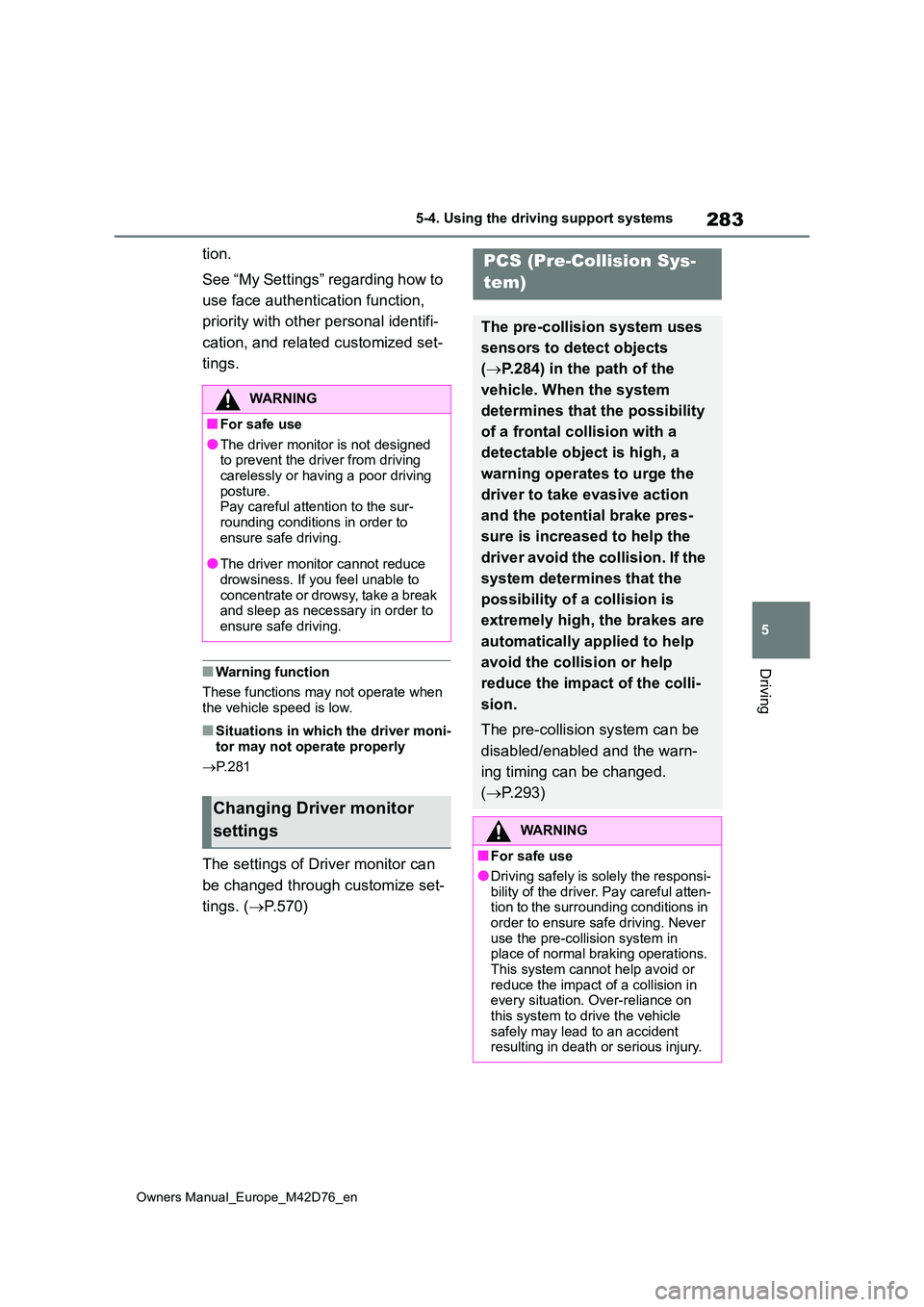
283
5
Owners Manual_Europe_M42D76_en
5-4. Using the driving support systems
Driving
tion.
See “My Settings” regarding how to
use face authentication function,
priority with other personal identifi-
cation, and related customized set-
tings.
■Warning function
These functions may not operate when the vehicle speed is low.
■Situations in which the driver moni-
tor may not operate properly
P. 2 8 1
The settings of Driver monitor can
be changed through customize set-
tings. ( P.570)
WARNING
■For safe use
●The driver monitor is not designed to prevent the driver from driving carelessly or having a poor driving
posture. Pay careful attention to the sur-rounding conditions in order to
ensure safe driving.
●The driver monitor cannot reduce
drowsiness. If you feel unable to concentrate or drowsy, take a break and sleep as necessary in order to
ensure safe driving.
Changing Driver monitor
settings
PCS (Pre-Collision Sys-
tem)
The pre-collision system uses
sensors to detect objects
( P.284) in the path of the
vehicle. When the system
determines that the possibility
of a frontal collision with a
detectable obj ect is high, a
warning operates to urge the
driver to take evasive action
and the potential brake pres-
sure is increased to help the
driver avoid the collision. If the
system determines that the
possibility of a collision is
extremely high, the brakes are
automatically applied to help
avoid the collision or help
reduce the impact of the colli-
sion.
The pre-collision system can be
disabled/enabled and the warn-
ing timing can be changed.
( P.293)
WARNING
■For safe use
●Driving safely is solely the responsi-
bility of the driver. Pay careful atten- tion to the surrounding conditions in order to ensure safe driving. Never
use the pre-collision system in place of normal braking operations. This system cannot help avoid or
reduce the impact of a collision in every situation. Over-reliance on this system to drive the vehicle
safely may lead to an accident resulting in death or serious injury.
Page 294 of 674
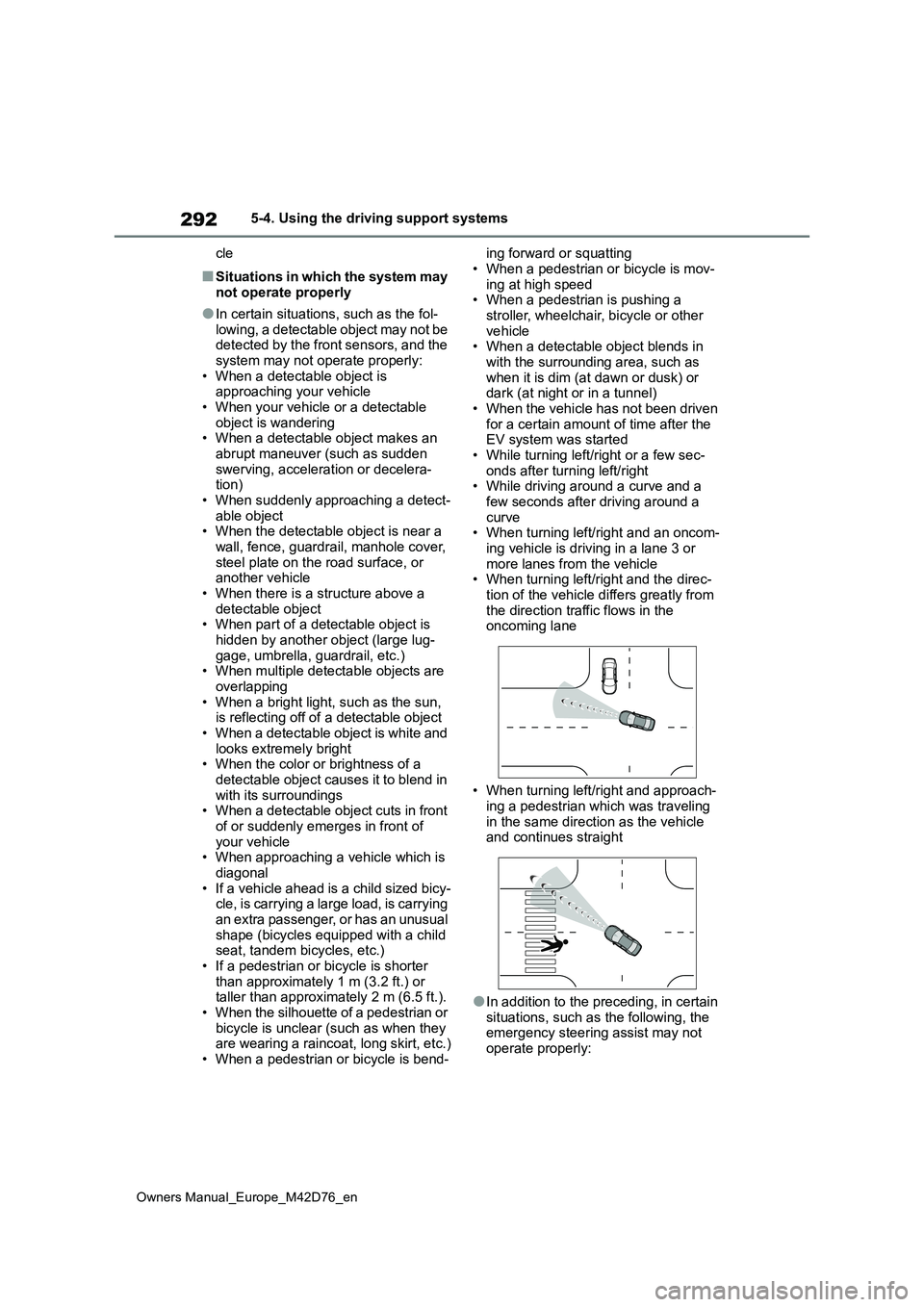
292
Owners Manual_Europe_M42D76_en
5-4. Using the driving support systems
cle
■Situations in which the system may
not operate properly
●In certain situations, such as the fol-
lowing, a detectable object may not be detected by the front sensors, and the system may not operate properly:
• When a detectable object is approaching your vehicle• When your vehicle or a detectable
object is wandering • When a detectable object makes an abrupt maneuver (such as sudden
swerving, acceleration or decelera- tion)• When suddenly approaching a detect-
able object • When the detectable object is near a wall, fence, guardrail, manhole cover,
steel plate on the road surface, or another vehicle• When there is a structure above a
detectable object • When part of a detectable object is hidden by another object (large lug-
gage, umbrella, guardrail, etc.) • When multiple detectable objects are overlapping
• When a bright light, such as the sun, is reflecting off of a detectable object• When a detectable object is white and
looks extremely bright • When the color or brightness of a detectable object causes it to blend in
with its surroundings • When a detectable object cuts in front of or suddenly emerges in front of
your vehicle • When approaching a vehicle which is diagonal
• If a vehicle ahead is a child sized bicy- cle, is carrying a large load, is carrying an extra passenger, or has an unusual
shape (bicycles equipped with a child seat, tandem bicycles, etc.)• If a pedestrian or bicycle is shorter
than approximately 1 m (3.2 ft.) or taller than approximately 2 m (6.5 ft.).• When the silhouette of a pedestrian or
bicycle is unclear (such as when they are wearing a raincoat, long skirt, etc.)• When a pedestrian or bicycle is bend-
ing forward or squatting
• When a pedestrian or bicycle is mov- ing at high speed• When a pedestrian is pushing a
stroller, wheelchair, bicycle or other vehicle• When a detectable object blends in
with the surrounding area, such as when it is dim (at dawn or dusk) or dark (at night or in a tunnel)
• When the vehicle has not been driven for a certain amount of time after the EV system was started
• While turning left/right or a few sec- onds after turning left/right• While driving around a curve and a
few seconds after driving around a curve• When turning left/right and an oncom-
ing vehicle is driving in a lane 3 or more lanes from the vehicle• When turning left/right and the direc-
tion of the vehicle differs greatly from the direction traffic flows in the oncoming lane
• When turning left/right and approach- ing a pedestrian which was traveling
in the same direction as the vehicle and continues straight
●In addition to the preceding, in certain situations, such as the following, the emergency steering assist may not
operate properly: